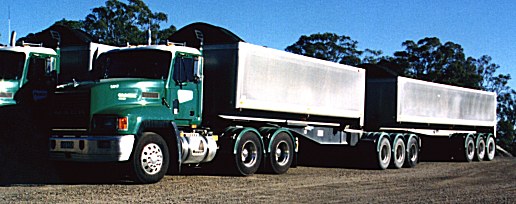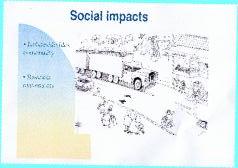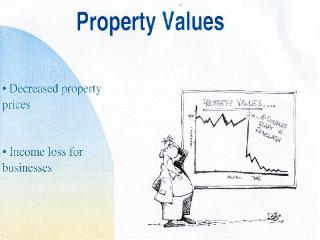Ranelagh Community Group

Introduction
Ranelagh
residents have enjoyed a lifestyle based on rural countryside and this
lifestyle has now been put in jeopardy by this proposal. We agree with Forestry Tasmania (DP&EMP
page 107, subsection 4.5.4) that transport traffic is a contentious issue in
rural communities, particularly where large changes in heavy traffic patterns
occur. This is exactly what is proposed
to happen to our community.
The
major issues for Ranelagh residents include:
·
irreversible
impacts on our lifestyle including noise and safety impacts, social and
economic impacts;
·
incomplete
information included in the DP&EMP to support the transport route option
chosen; and
·
process
issues such as community consultation and mitigation measures.
Each
of these issues is detailed below.
Irreversible impacts on lifestyle, amenity and property values
Truck impacts
The
DP&EMP (Page 127) notes that there will be a 148% increase in truck usage
on the North Huon Road and a 164% increase in truck usage on the Lollara Road.
This does not include the likely increase in truck usage associated with the
growth of private timber production (DP&EMP page 91,subsection 4.2.1).
The DP&EMP notes that there are 60 truck movements through Ranelagh per day (DP&EMP page 123, Table 36). Local experience suggests that 60 truck movements per day does not accurately reflect the traffic flow through Ranelagh township. Further information on sites chosen to monitor traffic is needed to ensure that data used in the DP&EMP accurately accounts for traffic through Ranelagh.
Further page 133 notes that principle haulage routes are needed when industry locations are not served by arterial roads. The wood centre is serviced by an extensive network of Forestry and State roads and therefore these roads should be used in preference to low traffic volume road such as North Huon Road.
The
Huon News (26 September 2001) states that ‘Forestry Tasmania wish to finalise
road signage in the area before the onset of the summer tourist season as the
new road will be subjected to significant traffic flows for traffic travelling
to and from the Tahune airwalk’. This
new road was the Judbury to Arve Road.
If the extension to the Huon Highway was built there is an addition
significant increase in traffic volume through Ranelagh.
Residences affected
The
number of residences affected by the preferred transport route are as set out
below (DP&EMP Page 143 Table 45):
·
Option
1 = 99;
·
Option
2 = 73
·
Option
3 = 1;
·
Option
4 = 56
This is based on residences close to the road. Clearly residences more that 30 metres from
the road will be affected by one or all of the impacts outlined in this
submission including noise and safety.
Option 1
affects the most residences of the four options in the DP&EMP.
Safety issues
As
described above in ‘Traffic impact’ there would be a significant increase in
truck, tourist and other vehicular traffic associated with this proposal. This would have major safety implications
for our community.
A
survey of 28 residences in March 2001 revealed that 90% of people surveyed had
a very high concern about safety impacts associated with the increase truck
volume along North Huon Road (Ranelagh Road Use Survey, Attachment 1). These impacts would include:
·
Changes
to established recreation patterns, ie travel to school, cycling, walking,
horse riding, visiting neighbours, short trips to the shop,etc;
·
Significantly increased safety risks to
children and the elderly;
·
Disruption
to road usage patterns
Looking at best Australian practice in the design of roads in the community, it is acknowledged that ‘safety of rural roads and the need to reduce road accident trauma are universal concerns of rural road users and residents’ (Austroads, 1997 page 218). Clearly this is relevant to the design of whichever road route is finally chosen.
Noise
The
DP&EMP refers to 6 day a week, 24 hour per day operations. This is an unpleasant departure from
previous advice from Forestry Tasmania representatives to the community that it
would be 5-6 days per week, 12 hours per day.
As well, the DP&EMP Appendix Q Indec Consulting Report, Page 23
refers to the proposal to operate the trucks 6 days per week, 12 hours per day,
7am to 7pm.
The DP&EMP notes that current measurements of traffic show that there are almost no truck movements before 7.00am or after 6.00pm (Page 123). In other words, the Ranelagh community has enjoyed a quiet rural environment.
The
24 hour per day, 6 day per week proposal is unacceptable on the following
grounds:
· The impacts on Ranelagh residents are, in some instances, unknown. Page 128 of the DP&EMP acknowledges that ‘there may be occasions when the recommended guideline is exceeded, depending on a number of factors, impacts on residents is unclear’ (our underlining).
· In addition, the peak noise level of a passing truck, 15 metres from the measuring device has been calculated to be 83.6 dB(A) while the levels calculated to cause sleep disturbance in 10% of the population are all exceeded given the truck volumes in the DP&EMP. The actual percentage of people disturbed at night may well be significantly greater.
Social impacts

Plate
2 on Page 110 shows the preferred route through the Ranelagh Playground. The DP&EMP states that community
representatives favoured the transport route through the Ranelagh Playground. In addition, Forestry Tasmania have
committed to providing another playground (Commitment 33).
The
Ranelagh Playground Committee believes the relocation of the park is
inappropriate for the following reasons:
* there are strong historical links with, and demonstrated commitment from the Ranelagh community;
* the playground has no vandalism because of its central nature and supportive community; and
* the playground has a secure play area with help close at hand.
Alternative
sites will not have these features. The
Ranelagh Playground Subcommittee has undertaken a range of information sharing
sessions with the Huon Valley Council, Forestry Tasmania and relevant
politicians.
Another
social impact is the potential dislocation of our community as many people may
choose to leave the area. This will
disrupt normal community links and activities.
Some people have indicated that they would not be happy to have their
house acquired compulsorily.
Property Values

The
potential loss in property values associated with this proposal are
significant. Many people have chosen to
live in Ranelagh because of its rural nature.
These people may not have made this choice if they could have foreseen
the impacts outlined in the DP&EMP.
An independent valuation of the impact of the proposed transport route
is needed to quantify this impact.
Further,
potential property homebuyers are less likely to purchase because of proximity
to major heavy haulage route.
Incomplete information included in the DP&EMP to support the transport route option chosen
The DP&EMP does not provide enough information to support the selection of Option 1 as the preferred transport route and therefore does not substantiate the analysis of options in Table 32, page 115 of the DP&EMP. In particular, the financial analysis for all four options is not included yet it is a major driver behind the selection of the preferred route.
Please find below a table that we believe more accurately reflects the advantages and disadvantages of the four options based on the information provided in the DP&EMP.
|
Option |
Advantages |
Disadvantages |
Residences affected |
|
Option
1 |
Most
economic Will
limit impacts in areas covered by Option 2, 3 and 4 |
Most
residences affected including noise and safety impacts, possible loss of
playground, decrease in property values, Initial
capital costs |
99 |
|
Option
2 |
Will
limit impacts in areas covered by Options 1, 3 and 4 Decrease
truck traffic flow through Hobart Already
included in Forestry Tasmania’s planning ** |
Increased
cartage costs Many
residences affected Steep
climbs along road# Significant
capital costs for road upgrades |
73 |
|
Option
3 |
Will
limit impacts in areas covered by Options 1,2 and 4 Least
residences affected Decrease
truck traffic flow through Hobart |
Steep
climbs along road Significant
capital costs for road upgrades |
1 |
|
Option
4 |
Will
limit impacts in areas covered by Options 1,2 and 3. Minor
cost for road upgrades |
Increased
cartage costs |
56 |
The
financial analysis of all four options should be made publicly available so
that informed comment can be provided by members of the public on the preferred
transport route.
Conclusion
When all of the above impacts are considered together it is clear that there will irreversible impacts on the Ranelagh community. It is unacceptable these days to have such wholesale impacts on small communities
Recommendation 1: That the DP&EMP include a condition that prohibits Option 1 from being the transport route for product from the ITPS
Process Issues
Community
consultation
Aspects
of Forestry Tasmania’s community consultation are to be commended. For example the establishment of the
Southwood Community Advisory Group, the tours to the Southwood site, the
conduct of public meetings early in the development of the project, and the
focus groups have all been positive efforts.
Lately,
however, consultation with Ranelagh residents has diminished and many Ranelagh
residents are unaware of the potential impacts of this project on their
lifestyle. Ranelagh residents have not been consulted since the Community
Values Workshop.
The
playground committee has had a meeting with Forestry Tasmania representative,
Mr Dario Tomat at the instigation of the Playground Committee. The Ranelagh Community Group has held a
public meeting to share information on the project. In both instances, the community has initiated the consultation
process not Forestry Tasmania.
This
will not be conducive to establishing a longterm, supportive community for this
project.
Recommendation 2: Forestry Tasmania to undertake comprehensive
community consultation with Ranelagh residents.
Recommendation 3:
The Community Consultation Committee referred to in Commitment 8 page 103 of
DP&EMP must be constituted and empowered through an appropriate permit
condition in the Development Approval and have a majority of members from the
area impacted by the Transport Route.
An independent arbitrator needs to be appointed for disputes.
Mitigation
commitments
The
spirit behind the commitments that are made in Chapter 4 of the DP&EMP to
mitigate the impacts of the transport activities is welcomed. However many commitments are too loosely
defined to offer any assurances for residents affected by the transport
route. The following commitments in
particular need to be more clearly defined so that their mitigative value can
be measured.
|
Commitment |
Comment |
|
1: Construction traffic will generally be
restricted to daylight hours. |
What does ‘generally’ mean and how can it be
measured? |
|
2: Speed restrictions for construction traffic will be imposed in sensitive areas. |
Need to define ‘sensitive areas’. |
|
3: Drivers will be given training with respect to operation on sensitive sections of the route during construction. |
Need to provide some details of the sort of
training that will be provided |
|
13 Design
HPVs and other product transport vehicles to minimise noise generation |
Need to provide the relevant design details |
|
P 146, first paragraph ‘These measures will also
be implemented during the construction phase as far as practicable’ |
Need to define ‘as far as practicable’. |
Recommendation 4: That all commitments are made conditions of approval of the DP&EMP and that the above commitments are made measurable
Summary of Recommendations
Recommendation 1: That the DP&EMP include a condition that
prohibits Option 1 from being the transport route for product from the ITPS
Recommendation
2: Forestry Tasmania to undertake
comprehensive community consultation with Ranelagh residents.
Recommendation 3: The Community Consultation Committee referred to in Commitment 8 page 103 of DP&EMP must be constituted and empowered through an appropriate permit condition in the Development Approval and have a majority of members from the area impacted by the Transport Route. An independent arbitrator needs to be appointed for disputes.
Recommendation 4: That all commitments are made conditions of approval
of the DP&EMP and that the above commitments are made measurable
References
Ranelagh
Road Use Survey (Attachment 1)
Austroads
1997, page Roads in the Community, Part II, Towards Better Practice, Kneebone
(Ed), published by Austroads Incorporated,, PO Box K659, Haymarket, NSW.
